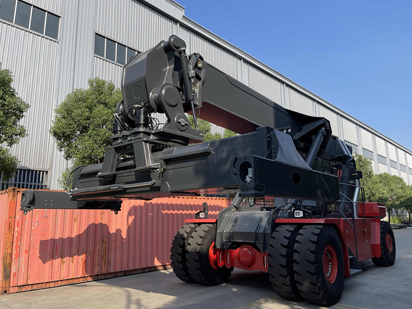How Does the Container Reach Stacker Perform Its Daily Duty?
There are many heavy-duty vehicles like excavators, forklifts, trucks, cranes, etc… that are designed to serve various industries. Reach stacker is one such vehicle used for handling containers, semi-trailers, and loose goods. The major contributions of this mobile machinery can be found in small terminals or medium-sized ports for handling intermodal cargo containers.
Reach stacker is a kind of crane for lifting and discharging containers, which belongs to hoisting machinery or port machinery since it is widely used in port, wharf to handle, transport and stack various containers. Compared with forklift, the stacker features flexibility, ease of operation, higher stability and efficiency. Generally, the stacker has no definite classification, its lifting appliance can be adjusted according to the container size.
The reach stacker consists of three parts including chassis, telescopic boom and container lifting appliances. The chassis system consists of engine, gearbox, steering system, cab, car frame and wheels. The telescopic boom consists of telescopic cylinder, derricking press and boom frame. The container lifting appliance consists of rotary device, upper-carriage, connecting carriage, under-carriage, telescopic cylinder and so on.
45 Ton Reach Stacker
The popular features of a reach stacker include speed, power, precision, low operational cost, efficiency, and more. This vehicle will help to transport large containers weighing tons to a shorter distance and also for stacking/unstacking the containers in rows based on the access. Flexibility, versatility, higher stacking, user-friendliness, strength, safe operation, and storage capacity are other key benefits of using reach stackers.
The appearance and operation of the reach stacker are similar to that of forklifts. But, reach stackers are more effective and safe for transporting heavy containers while comparing them with forklifts. The design of reach stackers consists of a boom, comfortable cabin, chassis, rotator, engine, hydraulic system, combi attachment, and more. The extended boom nose is a type of attachment that will help the reach stacker to easily pick containers below ground level. The auxiliary components like steering system, cooling circuit, braking circuit, and spreader actuators are also necessary to reach stacker working.
Reach stackers are available in the market with varying specifications. Lifting capacity, wheelbase, turning radius, and reach are some of those specifications that need to be considered while selecting one. The lifting capacity indicates how much load this mobile machine can carry and transport safely. The distance between the front and rear axles is known as the wheelbase. The radius of the smallest circle that can be created by this vehicle is the turning radius and it denotes how flexible and convenient the machine is. The reach of this vehicle is calculated by measuring the difference between the fully-retracted and fully-extended positions of the boom.
How does the container reach stacker perform its daily duty?
First, the container stacker will discharge the containers from the truck.
Second, stack the containers in the yard.
Third, grad the containers and transport them to the designated place.
Fourth, put the containers into the truck. When lifting the containers in the port site, the port machine should be close to the containers as much as possible to keep the machine in a stable condition.
The containers should be lifted straight, not slant. The distance between the container and the ground should be as low as possible when the port equipment stacker is travelling and the speed should not exceed 5 km/h, the travelling distance should not more than 100 meters. Sudden turn, over-speed and urgent braking are forbidden except special circumstances.

评论
发表评论